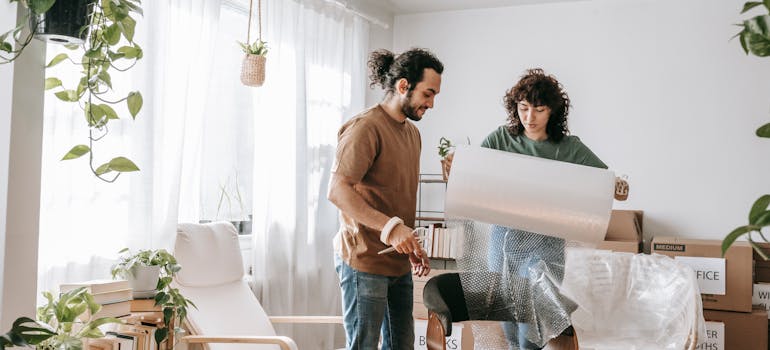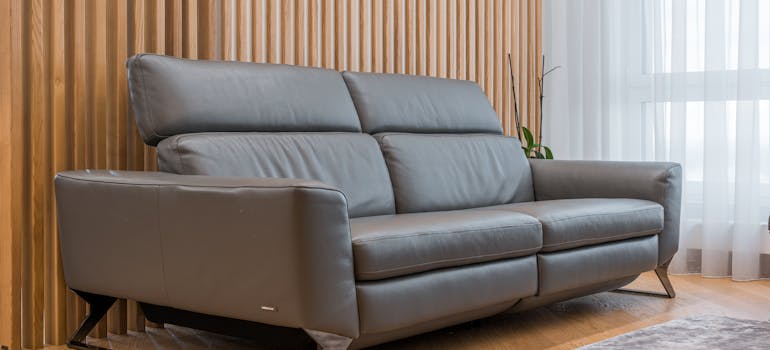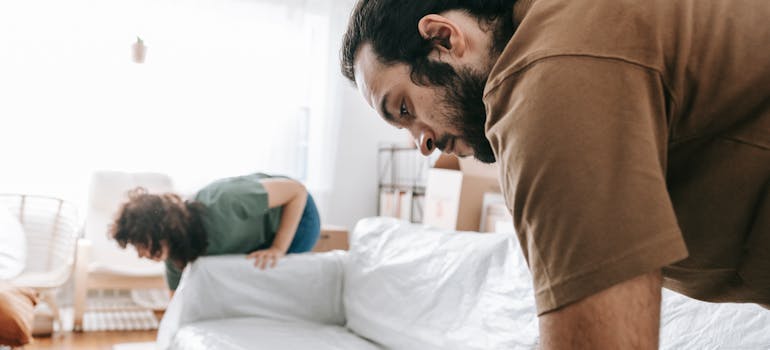Moving leather furniture isn’t like handling other types of household items. Leather, with its unique qualities and vulnerabilities, requires special attention to ensure it remains in perfect condition. Whether you’re relocating across town or to a new state, understanding how to move leather furniture properly so it doesn’t get damaged is very important. In fact, there are several essential steps you should know about to prevent common problems like scratches, tears, and environmental damage.
Pre-move preparation
Before you start with this tricky task you need to know that a little prep can go a long way. Here’s what to do:
- Clean the leather. Use a soft cloth and a mild leather cleaner to remove any dirt or oils. This prevents grime from being ground into the leather during the move.
- Disassemble if possible. Remove legs and any parts that are designed to come off. This reduces the risk of snapping or bending during the move.
- Take photos. Document the condition of your furniture before the move. This can help with insurance claims if damage occurs.
Necessary materials for protection
When moving leather furniture, it’s important to select the right protective materials. First, wrap your furniture in moving blankets. These thick blankets cushion against bumps and scratches during the move. Secure the blankets with packing tape, ensuring it doesn’t touch the leather directly as this can leave marks.
For an extra layer of protection, consider using stretch wrap. This plastic material keeps the blankets in place and protects against moisture. By the way, moisture is a key concern, especially in unpredictable weather. It’s a good idea to have a professional, like DC apartment movers, handle this part. They know how to wrap pieces tightly without damaging the leather.
Additionally, use corner protectors made from foam. These simple additions safeguard the vulnerable edges of your furniture, which are most susceptible to damage during shifts in transit.

Use the right techniques to move leather furniture properly
Proper lifting and moving techniques are essential to prevent damage to your leather furniture. Always lift your furniture from its strongest points. That is typically the base or frame. Don’t ever grab it by the cushions or arms. This prevents undue stress and potential warping of the structure.
For homes with stairs or long hallways, consider using a dolly or hand truck to move your leather pieces more efficiently. These tools reduce the strain on the movers and help avoid dragging the furniture across rough surfaces, which can cause tears or scuffs.
Of course, should you choose to enlist the help of professionals, such as the furniture movers in Washington DC, you won’t have to worry about this. They have the experience and equipment to handle your furniture correctly, ensuring it’s transported safely to its new location without any mishaps. In any case, make sure you take extra care when you are handling very heavy pieces as the risk of getting hurt or damaging them is higher.
Controlling the environment
To protect your leather during the move, controlling the environment is key. Here are some strategies:
- Avoid extreme temperatures. Leather can warp or crack in extreme cold or heat. Use climate-controlled transport if possible.
- Manage humidity. Too much moisture can cause the leather to mold. If you’re moving in damp conditions, consider using dehumidifiers.
- Minimize sun exposure. Keep leather away from truck windows to prevent sun damage and fading during transport.

Loading and positioning in the moving truck
To move leather furniture properly, you need to load and position it in the moving truck in such a way as to prevent damage during transit. Place leather items away from windows where sunlight can cause fading or heat damage. It’s best to position these items upright and not stack anything heavy on top that could compress and misshape the cushions.
Use non-slip mats under each piece to prevent shifting as the truck moves. Secure straps should be tight enough to hold the furniture in place but not so tight as to warp the frames. Make sure these straps are padded to avoid direct contact with the leather, which could lead to indentations or scuffs.
Many moving companies DC area offers are experienced in loading techniques and can ensure that every piece is optimally placed for transport. This practice reduces the risk of damage during the move.
Unloading and post-move care
Unloading your leather furniture carefully is just as important as how it was loaded. Begin by clearing a path to the final location of each piece. This prevents unnecessary movement and adjustments which can risk damage. Use a ramp or lift when removing furniture from the truck to avoid dragging or bumping into steps or curbs.
Once in place, give your leather a thorough inspection for any signs of stress or damage incurred during the move. Addressing issues early can prevent them from worsening. It’s also beneficial to apply a high-quality leather conditioner to replenish moisture lost during transport and help the material acclimate to its new environment.
Moreover, Washington DC movers often offer post-move services, including the placement and initial care of leather furniture, to ensure that it settles well in your new space. So, if you are not sure you can handle all this, give them, or an expert of similar stature a call.
Long-term storage tips
If you need to store your leather furniture, choosing the right conditions is crucial. Follow these tips:
- Climate control: Store leather in a climate-controlled facility to avoid extreme temperatures and humidity.
- Elevate furniture: Keep furniture off the floor on pallets to protect against dampness and pests.
- Cover properly: Use breathable covers, such as cotton sheets, to protect against dust without trapping moisture.

Safeguarding your leather furniture
In essence, those who know how to move leather furniture properly will tell you that the little details make a big difference. With the right preparation and care, you can protect your valuable items from the rigors of relocation. Remember, the effort you put into moving your leather pieces correctly pays off in preserving their look and longevity. Safe moving practices ensure that your furniture not only survives the move but continues to enhance your home for years to come.


